
มวยโคราช
มวยโคราชเป็นมวยท้องถิ่นของจังหวัดนครราชสีมา ซึ่งได้รับฉายาว่าเป็นเมืองมวย ในสายของครูบัว วัดอิ่ม เริ่มเรียนมวยไทยโคราชจากครูมวยพื้นบ้านชื่อผู้เฒ่าทน ครูรุ่ง และครูนิลที่หมู่บ้านดอนขวาง ซึ่งเป็นครูมวยฝีมือดี มีไหวพริบ และกลยุทธ์ทั้งในการต่อสู้และการสอนศิษย์ ลูกศิษย์ของท่านอีกคนหนึ่งที่มีชื่อเสียงมากคือ นายแดง รุ่งนิล (ภายหลังใช้นามสกุล เป็น ไทยประเสริฐ) ผู้เป็นหลานชายของพระเหมสมาหาร เจ้าเมืองโคราชในสมัยนั้น ต่อมานายแดงได้เข้ารับราชการและได้ชกถวายตัวหน้าพระที่นั่งต่อเบื้องพระพักตร์พระบาทสมเด็จ พระจุลจอมเกล้าเจ้าอยู่หัว จนได้รับพระราชทานบรรดาศักดิ์เป็นหมื่นชะงัดเชิงชก
เรื่องราวของหมื่นชะงัดเชิงชก สร้างแรงบันดาลใจให้ครูบัว ซึ่งขณะนั้นชื่อเดิมชื่อเหียบ ตั้งใจจะฝึกฝนมวย และได้ขึ้นเปรียบมวยชกกับนักมวยท้องถิ่นหลายบ้าน เช่น บ้านหัวทะเล บ้านโนนฝรั่ง บ้านใหม่ บ้านหัวครูช้าง บ้านตะคอง ฯลฯ โดยไม่แพ้ใครเลย ต่อมาครูบัวได้รับราชการทหารที่กองพันทหารม้า นครราขสีมา และมีโอกาสได้ฝึกฝนการขี่ม้าผาดโผนจนชำนาญ ครั้นพอครบเกณฑ์ปลดประจำการแล้ว ก็เดินทางเข้าหาโอกาสแสวงหาชื่อเสียงทางมวยที่กรุงเทพ โดยขอพักอยู่กับพี่เขย คือ คุณพระสุนทรเทวภักดี ถนนข้าวสารซ้อมมวยอยู่ที่บ้านท่าน
ครูบัวได้แสดงฝีมือในการชกมวยอยู่หลายครั้ง ปราบนักมวยหัวเมืองได้หลายคนจนหาคู่ต่อสู้ด้วยยากจนได้รับเชิญให้ครูไปสอนมวยไทยให้แก่คณะดาวทอง ของป๋าหวาด เสตะปุระ ต่อมาจึงมาตั้งคณะของตนขึ้นที่ซอยโซดา ถนนสุโขทัย มีลูกศิษย์หลายคนที่ชกชนะ ชื่อเสียงโด่งดัง และจะมีคำว่า”โซดา” พ่วงท้ายชี่อ เช่น ทองอยู่ ชูโซดา ซัน กลั่นโซดา เป็นต้น จนถึงปี พ.ศ. ๒๔๗๓ ครูบัวได้รับการบรรจุให้เป็นครูพลศึกษา โรงเรียนนายร้อย จปร.ในสมัยนั้น ครูจึงได้ถูกส่งให้ไปฝึกวิชาอาวุธโบราณ จากครูเปลี่ยน บ้านเจริญพาสน์ วิชายูโด จาก อ.ฮิดาก้า ที่สีลมวิชามวยปล้ำจาก อ.เจือ จักษุรักษ์ และ ครูบัว ยังมีความสนิทสนมกับปรมาจารย์กิมเส็ง ทวีสิทธิ์ มวยทวีสิทธิ์ และปรมาจารย์เขตร ศรียาภัย มวยไชยา ทำให้ครูบัวมีโลกทัศน์ที่กว้าง และไม่เคยดูหมิ่นหรือแคลนวิชาของใครเลย แต่เมื่อเวลาท่านฝึกสอนมวยไทย ท่านก็จำแนกไว้โดยชัดเจนว่าท่าใดมาจากวิชาใด และหากท่านสอนมวยโคราช ท่านก็สอนมวยโคราชดั้งเดิม เป็นหลัก หลังจากท่านชกมวยจนหาคู่เปรียบไม่ได้แล้ว ท่านจึงแขวนนวมเมื่ออายุ ๔๐ ปี และทำหน้าที่ครูพลศึกษาให้แก่ นนร. จปร. จนเกษียณในปี พ.ศ. ๒๕๐๑
เอกลักษณ์และอัตลักษณ์ การจดมวยพื้นฐาน
ท่ามือในการจดมวยโคราชนั้น เริ่มตั้งแต่ใช้มือหน้าเสมอจมูก มือหลังวางคาง แล้วเหยียดแขนสองข้างออกข้างหน้า ระดับสูงต่ำของมือปรับเปลี่ยนได้ตามระยะของการเผชิญหน้าคู่ต่อสู้ ถ้าเข้าใกล้ยกมือขึ้นสูงได้ ระยะไกลลดมือลงต่ำคุมกลางตัว สันหมัดตั้งหรือเกือบตั้งฉาก ทั้งสองหมัด ลักษณะคล้ายกับตัว ก. ไก่ จึงเรียกขานท่านี้ว่า ท่าตัว ก. ซึ่งถือเป็นท่าครู ท่าปฐมส่วนขาสองข้างยืนแยกหน้าหลัง เท้าที่อยู่ข้างหน้ายืนเหยียบเต็มฝ่าเท้า ขาข้างที่อยู่ข้างหน้า ยืดเกือบตึง คือไม่มีมุมงอของเข่าให้เห็น แต่ที่จริงไม่ถึงกับตึงจนสะบ้าเคลื่อน ตรงพอสะบ้าลงหลุม จับได้ไม่คลอน น้ำหนักลงเต็มเท้าหน้า เท้าหลังจึงพร้อมสะบัดออกเป็นอาวุธ เตะ ถีบหรือเข่าได้ทันที เข่าหน้าไม่งอย่อลงให้ใครปีนเหยียบได้ และไม่นิยมปีนป่ายเหยียบชายพก หากจะใช้อาวุธก็จะโยนมวลทั้งตัวขึ้นจากพื้นในท่ารัดกุม
การจดมวยโคราช เหมือนตัว ก. ไก่เป็นพยัญชนะตัวแรกของอักษรไทย (ลักษณะดังภาพประกอบ) มีคำกล่าวในหมู่ชาวมวยว่า มวยอีสานเขย่งตีนยืน เพราะดินมันร้อน ต้องผ่อนตีนสลับ ขยับย่าง ไม่ว่าจะเป็นเรื่องจริง หรือคำเปรียบเปรยแต่ก็สะท้อนอัตลักษณ์นี้ได้ชัดเจน จึงทำให้มวยโคราชในเกือบทุกสาย ถนัดการออกอาวุธเตะสลับซ้าย ขวาได้คล่องแคล่ว
อีกหนึ่งในลักษณะเฉพาะของมวยโคราชสายครูบัว วัดอิ่ม (ร.ท.บัว นิลอาชา) ก็คือการใช้แกนตัวส่งกำลังในแนวตั้งมากกว่าการกระดกหรือเอนตัวในแนวนอน เนื่องจากครูเคยรับราชการทหาร (ในปี พ.ศ.๒๔๕๘-๒๔๖๐) และสอนมวยที่โรงเรียนนายร้อย จปร. ระหว่าง พ.ศ. ๒๔๗๓-๒๕๐๑) และเล็งเห็นว่า ในการออกปฏิบัติการในสนามรบ หากต้องรบพร้อมกับเครื่องหลังติดกายย่อมไม่สะดวกในการโยกตัว หรือก้มเงย แต่การหมุนแกนร่างกายในแนวตั้ง และการยืดย่อ การออกอาวุธ ชกเตะจะคล่องตัวกว่า การชกจะออกหมัดในแนวตั้ง การเตะจะเป็นการเตะห้ามไหล่ พับเป็นศอกข้างเดียวกับเท้าที่เตะเป็นการเตะสวนลงข้างชายโครง แต่ไม่สับปลายมือทิ้งลงข้างตัว ส่วนลักษณะที่พ้องกับมวยในบางสายก็คือการออกอาวุธพันลำ คือสลับอาวุธไม่ซ้ำลูก และการรับพร้อมรุกในจังหวะเดียวคล้ายกับมวยไชยา
การใช้อวัยวุธ
๑. หมัดตั้ง สำหรับการชกตรง ใช้หมัดหงานยเฉพาะกการต่อยขึ้น และใช้สันหมัดเหวี่ยงในวงกว้าง
๒. ศอกวงแคบสั้น มักใช้ตีโดยให้ท่อนแขนยังบังใบหน้า บางคราวใช้ประกอบกับเข่า
๓. เข่าเน้นการเข่าตรง
๔. การเตะในมุมพิเศษอยู่ระหว่างมุมตรง และมุมเฉียง คล้ายเตะลิดแต่มีเคล็ดวิชาในการใช้ทั้งมุมและจังหวะ แต่ไม่ใช่มุมคว่ำแข้ง เหมือนมวยใต้
ลักษณะที่ไม่พบในมวยโคราชสายดั้งเดิม
๑. ไม่นิยมการยกศอกต่อเข่าแบบยกบัง หรือย่างสามขุมในมวยไชยา หรือย่างสูงในมวยทวีสิทธิ์ แต่ตอบแก้ด้วยการกระตุกเข่าหรือใช้กลเท้าอื่น
๒. ไม่นิยมการปีนขาเหยียบหน้าตัก และไม่ยืนย่อขาให้ใครขึ้นปีนเหยียบ
๓. ท่าเตะแบบคว่ำแข้งที่บางคณะเรียกกันว่าเตะคอขาด ไม่ใช่ท่าเตะของมวยโคราช แต่ท่านั้นลักษณะใกล้เคียงกับมวยใต้ในชื่อ อุปราชขาดคอช้าง)
๔. หมัดเหวี่ยงของโคราช มีชื่อดั้งเดิมว่า “หมัดเหวี่ยง” ส่วนชื่อ”หมัดเหวี่ยงควาย”เป็นชื่อที่มวยสายอื่นใช้เรียก ตาม ๆ กันมา แต่ในสายโคราชเองเรียกเพียงแต่หมัดเหวี่ยง และหมัดนี้ไม่นิยมใช้เป็นไม้รุก แต่นิยมใช้เป็นไม้ตอบแก้
๕. การกระโดดชก ไม่ใช่ไม้หลักของมวยโคราช แต่เป็นไม้เกร็ดที่แตกมาจากการฝึกไม้หนึ่งของโคราช ซึ่งใช้เฉพาะการทำต่อเนื่องจากการเตะ
ทักษะพื้นฐานและไม้มวย
นอกจากลักษณะการจดมวยแล้ว ยังมีพื้นฐานของการออกอาวุธ อยู่กับที่ ๕ ท่าเคลื่อนที่ อีก ๕ ท่า และท่าฝึกการป้องกันตอบแก้ อีก ๑๑ ท่า เมื่อฝึกพื้นฐาน
จนคล่องแล้ว จึงให้ขึ้นไม้ครูพื้นฐานอีก ๕ ไม้ คือ ชักหมัดมา เตะตีนหน้าพร้อมหมัดชัก / ชักปิดปกด้วยศอก / ชกห้ามไหล่ / เมื่อเข้าให้ชกนอกเมื่อออกให้ชกใน / ชกช้างประสานงาจนเมื่อเข้าใจและปฏิบัติได้จนชำนาญแล้ว จึงขึ้นลูกไม้อีก ๒๑ ไม้ คือ ทัศมาลา/ กาฉีกรัง/ หนุมานถวายแหวน/ ล้มพลอยอาย/ ลิงชิงลูกไม้ /กุมกัณฑ์หักหอก /ฤๅษีมุดสระ/ ทศกัณฑ์โศก /ตะเพียนแฝงตอ / นกคุ้มเข้ารัง /คชสารกวาดหญ้า / หักหลักเพ็ชร / คชสารแทงโรง / หนุมานแหวกฟอง / ลิงพลิ้ว / กาลอดบ่วง/หนุมานแบกพระ/ หนูไต่ราว/ ตลบนก /หนุมานถอนตอ / โกหก (คำเดิมท่านเรียกไม้ตอแหล)
“ที่มาของข้อมูล นายสมศักดิ์ วิวัฒน์ไพศาล”
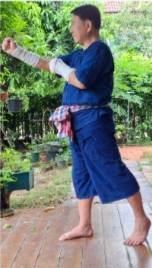
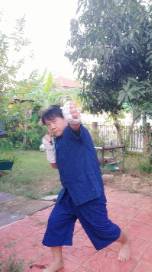
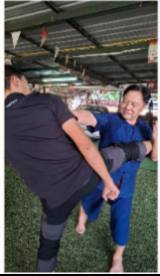
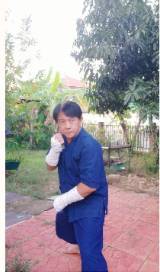
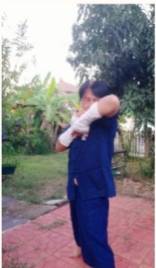

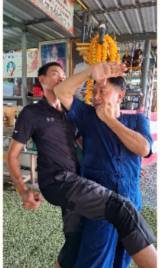
Muay Korat
Muay Korat is the indigenous style of Muay Thai originating from Nakhon Ratchasima Province, historically renowned as the “City of Boxing.” This style was propagated through the lineage of Kru Bua Wat-Im, who first studied traditional Muay Korat under local masters—Phu Thao Thon, Kru Rung, and Kru Nil—from Ban Don Khwang. These masters were renowned for their exceptional skills, tactical intelligence, and the ability to impart both the art and strategy of combat to their students.
Among their most distinguished students was Mr. Daeng Rungnil (later known as Daeng Thaiprasert), a nephew of Phra Hemsamaharn, the governor of Nakhon Ratchasima at that time. Mr. Daeng later served in the royal court and had the honor of performing a Muay Thai demonstration before His Majesty King Chulalongkorn (Rama V). His performance earned him the royal title “Muen Cha-ngad Choeng Chok” —meaning “The Skilled One of the Fighting Art.”
The story of Muen Cha-ngad Choeng Chok greatly inspired Kru Bua, whose birth name was Hieb. Determined to master the art of Muay Korat, he fought many local champions from surrounding villages—Ban Hua Thale, Ban Non Farang, Ban Mai, Ban Hua Khru Chang, and Ban Takhong—remaining undefeated. Later, Kru Bua enlisted in the cavalry regiment in Nakhon Ratchasima, where he honed his equestrian and acrobatic riding skills. After completing his military service, he journeyed to Bangkok in search of fame in the art of Muay Thai.
He stayed with his brother-in-law, Khun Phra Sunthorn Thewapakdi, on Khao San Road, where he trained diligently. Kru Bua showcased his talent in several bouts, defeating many provincial fighters until he became a highly respected name in Bangkok’s Muay Thai community. His skill eventually led to an invitation to teach Muay Thai for the Dao Thong Troupe, owned by Pa Wat Setabura. Later, he established his own boxing camp on Soda Alley, Sukhothai Road, producing many successful fighters who appended the name “Soda” to their ring names, such as Thongyoo Chu Soda and Sun Klan Soda.
By 1930 (B.E. 2473), Kru Bua was officially appointed as a Physical Education Instructor at the Chulachomklao Royal Military Academy (CRMA). During his tenure, he was sent to study various martial disciplines:
- Traditional Weaponry under Kru Plian, Ban Charoen Phat,
- Judo under Sensei Hidaka at Silom,
- Wrestling under Kru Chue Jaksurak, and
- maintained close relationships with Grandmaster Kim Seng Thawisit (Muay Thawisit) and Grandmaster Khet Siriaphai (Muay Chaiya).
These experiences broadened Kru Bua’s martial worldview. He was known for his humility—never looking down on other martial systems. However, when teaching, he carefully distinguished between techniques from each discipline. When he taught Muay Korat, he preserved and emphasized its authentic traditional principles.
After decades of competition, having no worthy opponents left, Kru Bua retired from active fighting at the age of 40, dedicating himself fully to teaching Physical Education and Muay Thai at the Royal Military Academy until his retirement in 1958 (B.E. 2501).
Identity and Distinctive Characteristics of Basic Anchoring (Jot) in Muay Korat
The hand anchoring posture (jot muay) in Muay Korat begins with the lead hand positioned roughly at the level of the nose while the rear hand rests by the chin. Both arms are then extended slightly forward. The vertical height of the hands is adjusted according to the engagement distance: when the fighter closes in, the hands are raised higher; at longer ranges the hands are lowered to control the midline. The fists are presented with the knuckle ridge vertical or nearly perpendicular — both hands forming a shape reminiscent of the Thai consonant "Ko Kai" (ก); hence this posture is commonly referred to as the “Ko Kai position” (Tha Tua Ko), which is considered a canonical Tha Kru (teacher’s stance) and a primary foundational posture.
The lower-body configuration is a staggered stance with weight distribution front-to-back. The lead foot is planted flat, the front leg nearly straight — not visibly flexed at the knee — though not hyperextended; the knee and patella settle into a stable alignment so the joint is secure and not loose. Full weight is borne on the front foot so the rear foot is primed to whip out as a weapon — to kick, teep (push-kick), or drive the knee instantaneously. The front knee is kept firm and not collapsing inward, preventing the opponent from stepping onto or climbing over the thigh. If the practitioner elects to use a weapon (strike) from this posture, the force is generated by driving the entire body mass upward from a compact, guarded structure rather than by flailing the limb.
The imagery of the Ko Kai character as the starting letter of the Thai alphabet is invoked in Muay Korat pedagogy (see illustrative diagram). A common saying among Isan fighters — “Muay Isan yeang teen yuen” (Muay of the Northeast stands on tiptoe because the earth is hot) — whether literal or metaphorical, reflects this regional identity: fighters habitually shift weight and step lightly, which contributes to Muay Korat practitioners’ fluency in alternating left–right kicking patterns.
A distinctive technical emphasis in the Kru Bua (Wat Im) lineage (Lt. Col. Bua Nila-acha) is the preferential use of the body’s vertical axis to transmit force rather than lateral or horizontal torso rotation. This emphasis derives partly from Kru Bua’s military and cavalry background and his experience teaching at the Royal Military Academy: on the battlefield, with gear and load carried, large horizontal displacements or deep bending are impractical. Thus, generating power by rotating the body about a vertical axis and through compact extension–retraction (rise–drop) makes strikes and kicks more practical and reliable under load. Punches are delivered on a vertical line; kicks are executed as short, shoulder-height strikes with the torso folding slightly and the elbow on the same side acting in concert with the striking leg — often delivered to the opponent’s lower ribs as a descending, penetrating action — while not dropping the hand away from the body. Shared with other traditional styles is the concept of alternating multi-weapon sequences (phan lam) — delivering non-repetitive, serial strikes and combining defense-with-immediate-offense — a trait that resembles aspects of Muay Chaiya.
Use of Weapons / Primary Striking Implements
- Vertical Fist (Mat Tang / “standing fist”) — Used for straight, ascending/vertical strikes. Emphasis on an upright fist (knuckle ridge vertical) for both direct punching and for wide arcing power shots.
- Short Narrow Elbow (Sok Wong Khâp San) — Employed in close quarters; the forearm often remains guarding the face while the elbow delivers short, penetrating strikes. Sometimes combined with knee actions.
- Knee (Kao) — Emphasis on straight, driving knee strikes, delivered with vertical power transmission.
- Special-Angle Kicks — Kicks in Muay Korat occupy a plane between the direct (frontal) angle and the oblique (diagonal) angle — somewhat similar to teh lit (a slicing or angled kick) but with specific timing and angular application. These are not the inverted shin-rotation low kicks typical of some southern styles; rather they employ distinct angles and timing unique to the Korat repertoire.
Characteristics Absent in the Traditional Muay Korat Lineage
- Elbow–Knee Combination Guard — Traditional Muay Korat does not favor the lifting of the elbow to block in conjunction with a raised knee (yak sok tor khao), as seen in the “Yang Sam Khum” (three-step advance) of Muay Chaiya or the “Yang Soong” (high stepping posture) of Muay Tawee Sit. Instead, defensive countermeasures are executed by jerking the knee (kratuk khao) or by employing alternative footwork strategies (kon thao).
- No Climbing or Leg-Stepping Techniques — Muay Korat discourages techniques involving stepping onto an opponent’s thigh (pin kha) or allowing one’s leg to be climbed upon by lowering stance. Practitioners are trained to maintain leg integrity and avoid yielding base height for leverage exchanges.
- Prohibited Downward Shin Kick — The downward chopping kick, often termed “Teh Kor Khat” (“decapitating neck kick”) in some lineages, is not a traditional Korat technique. The motion resembles that of Southern Muay (Muay Tai), specifically the form known as “Upparat Khat Kor Chang” (“The Viceroy Severs the Elephant’s Neck”).
- Swing Punch (Mat Wiang) — In original Muay Korat terminology, the wide circular punch is traditionally called simply “Mat Wiang” (swinging punch). The later colloquial term “Mat Wiang Kwai” (“Buffalo Swing Punch”) was introduced by practitioners of other regional lineages and subsequently adopted in common usage. In the Korat system, however, the Mat Wiang is not used as an initiating attack, but rather as a counter-striking technique (mai tob kae).
- Jumping Punch (Chok Kodon) — Jumping strikes are not considered core fundamentals (mai luk) of the Muay Korat curriculum. They are instead classified as supplementary techniques (mai kret), derived from the primary first form (mai nueng) and employed only as follow-up actions after kicking sequences.
Fundamental Techniques and Core “Mai Muay” (Forms)
Beyond the characteristic anchoring posture (jot muay), Muay Korat training emphasizes foundational weapons drills through a structured curriculum of:
- 5 stationary offensive positions,
- 5 mobile positions (movement-based techniques), and
- 11 defensive and counter-response postures (tob kae).
Once the practitioner achieves proficiency in these foundational structures, they progress to the five primary teacher’s forms (mai kru), which include:
- Chak Mat Ma — Retracting the fist while delivering a front-foot kick with a simultaneous pulling punch.
- Chak Pit Pok Duay Sok — Drawing inward to close guard with an elbow.
- Chok Ham Lai — A punch to prevent shoulder entry.
- Meua Khao Hai Chok Nok, Meua Ok Hai Chok Nai — “When advancing, strike outside; when retreating, strike inside.”
- Chok Chang Prasan Nga — “The Charging Elephants Collide.”
After mastering the five foundational forms, the student advances to twenty-one advanced techniques (mai look mai):
- Tatsamala
- Ka Cheek Rang (Crow Tearing the Nest)
- Hanuman Thawai Waen (Hanuman Presents the Ring)
- Lom Ploy Ai (Falling Together in Shame)
- Ling Ching Look Mai (Monkey Steals the Fruit)
- Kumkan Hak Hok (Guardian Breaks the Spear)
- Rue-si Mut Sara (Hermit Dives into the Pool)
- Totsakan Sok (Ravana in Grief)
- Tapian Faeng Tor (Carp Hiding in the Stump)
- Nok Khum Khao Rang (Partridge Enters the Nest)
- Kotchasan Kwat Ya (Elephant Sweeps the Grass)
- Hak Lak Phet (Breaking the Diamond Pillar)
- Kotchasan Thaeng Rong (Elephant Pierces the Hall)
- Hanuman Waek Fong (Hanuman Parts the Foam)
- Ling Phliu (Agile Monkey)
- Karn Lot Buang (Time Escapes the Loop)
- Hanuman Baek Phra (Hanuman Carries the Lord)
- Nu Tai Rao (Mouse Climbs the Pole)
- Talop Nok (Reversing Bird)
- Hanuman Thon Tor (Hanuman Uproots the Stump)
- Koh Hok — the ancient term “Mai To Lae” (the Deceptive Form).
The source of the information, Mr. Somsak Wiwatpaisarn
